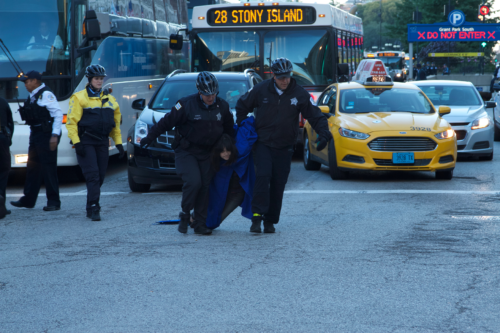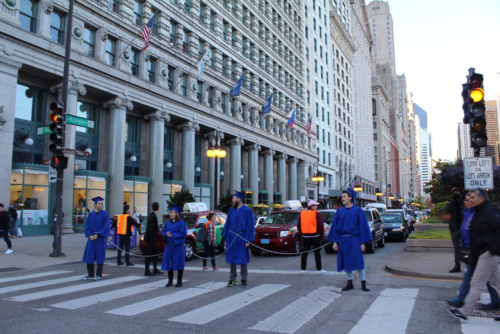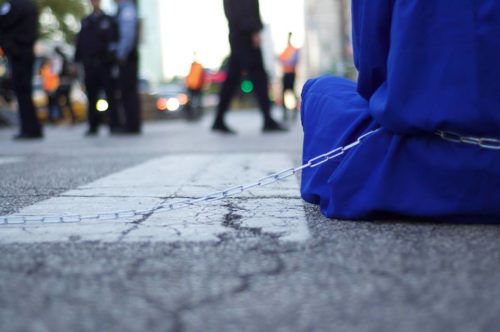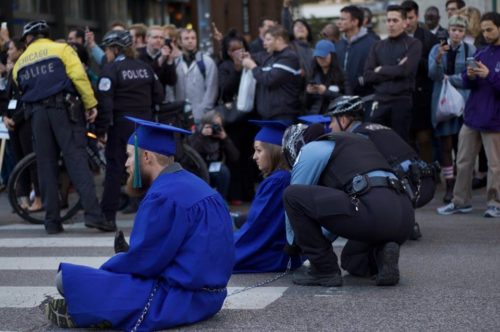On the afternoon of October 24, around 150 student activists and allies halted traffic on Michigan Avenue at Adams Street in front of the Art Institute of Chicago during a protest that called for improved funding practices for public higher education. Erica Nanton, an organizer and Roosevelt University alumna, quipped, “Paintings do not come before people.”
Chicago Student Action (CSA), a network of student organizers from Roosevelt University, Illinois Institute of Technology, University of Illinois at Chicago, University of Chicago, Northwestern University, and Governor’s State University, was behind the action. The demonstration was a part of the Moral Mondays Illinois series of protests, which is organized by Fair Economy Illinois, but this action was spearheaded by CSA.

At the demonstration, onlookers snapped photos as students in caps and gowns participated in a mock graduation ceremony. When students went up to receive their diplomas, they were intercepted by cardboard cutouts—the huge heads of Governor Bruce Rauner and billionaire Kenneth Griffin, Rauner’s largest political donor and the richest man in Illinois. Each student who had their diploma taken by “Rauner” and “Griffin” also gave testimony detailing their own stake in the fight for free, fully funded higher education across the state. Students shared a range of personal stories, from the impact of their undocumented citizenship status on their access to higher education to how cuts in funding made it impossible for them to continue in school.
But the protest put a particular focus on ensuring stable funding for the Monetary Award Program (MAP) to universities in Illinois. MAP grants awarded by the state help give low-income students the chance to attend college without falling too far into debt, but the program has become one of the biggest victims of Illinois’s legislative budget battle. The state failed to fund MAP grants for the 2015-16 academic year until well into the year, forcing many students to leave school for a period of time. This year, the process is set to repeat: as universities extend grants to students on credit, many of the students are left in a state of uncertainty regarding their academic future.
Illinois Institute of Technology (IIT), located at 33rd Street and State Street in Bronzeville, was one of many institutions counting on the state legislature to continue funding higher education last year, in part so it could provide its students with MAP grants. During the fall of 2015, after the state budget impasse had already gone on for months, IIT placed what were essentially placeholder grant credits in the accounts of students who were expecting to receive MAP grants as tuition aid. In the face of legislative stagnation in Springfield, IIT took an optimistic approach that allowed for its students to enroll in classes and continue their education.

In general, MAP grants are vital for improving the financial accessibility of higher education for some of Illinois’s more vulnerable people. Fifty-seven percent of MAP grant recipients are first-generation college attendees, more than half of all black or Hispanic students who attend public universities in Illinois are MAP recipients, and fifty-eight percent of MAP recipients come from such low-income backgrounds that the federal government does not expect them to contribute any resources to pay for college. To be eligible for a MAP grant, a student must be an Illinois resident who exhibits need based on the information provided on their federal student aid application. The student must also attend one of Illinois’s MAP-eligible institutions. In Chicago, there are thirty-three MAP-eligible colleges for the 2016-2017 school year, ten of which are on the South Side. MAP grants are awarded by the Illinois Student Assistance Commission based on allocations in the state budget as approved by the state legislature.
On December 16, 2015, IIT released a public statement urging all students to take part in the #MAPMatters discussion through posts on social media, and to call Rauner’s office and the office of their local state representative. The statement appealed to a collective sense of responsibility: “If we work together, we can make a difference in Illinois’s legislative process and bring back the MAP Grant to over 700 Illinois Tech recipients who count on this funding each year.”
But on March 23, 2016, during Illinois’s eighth month without a state budget, and with no sign of resolution from Springfield, IIT students received a letter from Michael Gosz, the university’s Vice President for Enrollment, that said, “The university can no longer maintain the pending MAP credit that was issued to your student account.” Registration for the summer and fall semesters was set to open just twelve days later, on April 4. The news meant that students who could not pay the amount of MAP credit they were promised would not be able to register for summer and fall semesters.

Esau Chavez, who organizes with CSA, was one of the more than seven hundred IIT students impacted by the state’s failure to allocate last year’s MAP grants. The withdrawal of the placeholder grant from students and the option to take on a loan proved costly for many students like Chavez. He has now been forced to take three consecutive semesters off from school in order to save funds and repay his debts to the university. “From early on, it was evident that you had to get a job to pay for expenses,” he says. “I had to consider loans. With loans, I would be able to focus more on being in class.”
Before the spring semester of 2016 began, Chavez realized his return to IIT would not be possible because of unpaid debts. He was able to take advantage of his forced time off to work on a progressive Democrat’s campaign and find a summer internship later in the year, and because of that work he now only has about $500 left to pay IIT. He hopes to return to campus as a full-time student in the spring semester of 2017.
“My generation has been told over and over again that education is the pathway to a better life, but cuts to higher education funding forced me and thousands more to drop out of school for a period of time,” Chavez said in a CSA press release. Given the fact that fifty-eight percent of MAP grant recipients have no expected family contribution, it’s likely that Chavez’s decision to leave school for some time is common across the city and state.
Although he was forced to leave school, Chavez speaks positively of IIT, saying the school did its best to help him continue his education. “[Those in IIT’s Office of Financial Aid] try to work with you,” he says.
On April 22, 2016, a month after IIT announced it would no longer extend MAP credit to its students, Illinois lawmakers approved spending $600 million on higher education for the fiscal year that had begun in July 1, 2015. A few days later, IIT announced that it would receive partial payment, likely in the amount of funding awarded for the fall 2015 semester, on the 2015-16 MAP grants that were awarded to eligible students. That meant students only owed unpaid MAP grants from the spring semester.

S.—who later asked to remain anonymous for work and security-related reasons—a junior at IIT, took out a loan with a family friend and picked up extra hours at work to cover the balance of his semester without MAP funding. “I have a good scholarship and am luckier than many other students, but having to work extra to pay off the gap—it’s been a real burden,” he said. “I always have to calculate whether or not I will be able to continue my education here.”
A day before the July 1, 2016 deadline, Rauner signed a budget that provides $1 billion dollars to Illinois higher education through December 31, 2016. This budget included $151 million allocated to finish repaying universities and colleges; the funding allocated MAP grant money to students for the previous year, and meant that students’ debts from the spring were ultimately covered.
But while the budget ensured that higher education institutions would remain open for the fall 2016 semester, it still leaves students and institutions in suspense regarding funding for the entire 2016-17 academic year. And though the Illinois Student Assistance Committee awarded MAP grants for this academic year, it has been unable to fulfill these awards because the state budget for the full fiscal year has, again, not been finalized. The Illinois General Assembly is expected to convene again in a few weeks, with many hoping that finalizing a full budget will be at the top of the docket. Until then, students are in much the same uncertain position as last year, choosing either to take another precarious line of credit from their school, or simply to unenroll.
It is in the midst of this uncertainty that a student protest movement fighting for higher education funding, one with carefully chosen targets and venues, has arisen. Griffin, the billionaire businessman and Rauner donor, is also a trustee at the Art Institute. In early 2016, he bought two contemporary paintings for a combined $500 million. For comparison, during the 2015 fiscal year the Illinois Student Assistance Commission awarded $357 million in MAP grants to about 128,000 students across Illinois.
And while MAP grants were a central issue at the October 24 action at the Art Institute, one of the aims of this student movement has also been to emphasize that, at least eventually, a reliance on sporadically funded grants should not be necessary to access higher education. The action ultimately called for totally free higher education, in which the cost of tuition is covered and subsidies are provided for students based on their need for housing, fees, and books.
“We want to give the public the view that free public education in Illinois is possible,” said Chavez.

